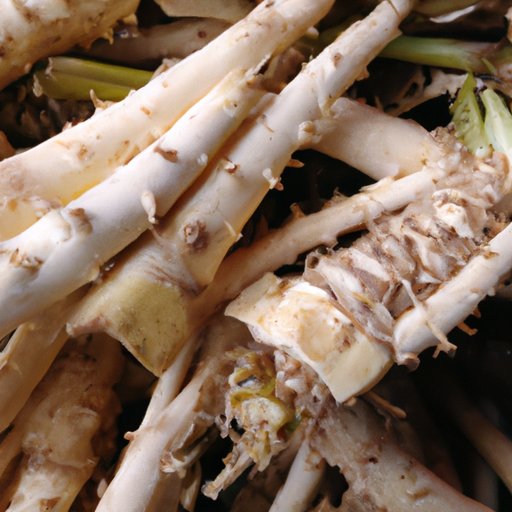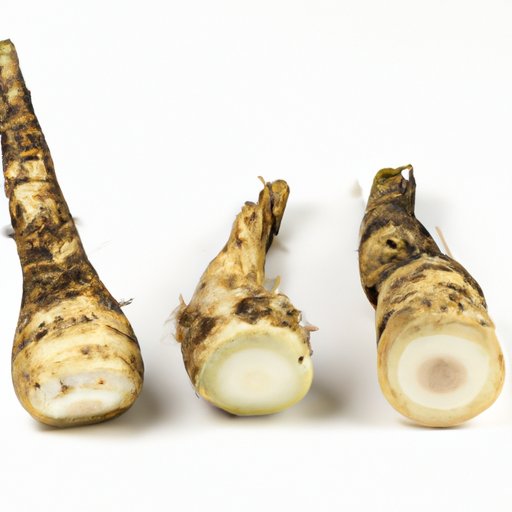
I. Introduction
Horseradish is a versatile ingredient that has been long cherished for its tangy, pungent flavor. Whether you’re grating horseradish root to make your own sauce, or adding it as a garnish to a Bloody Mary, horseradish is an essential ingredient in many kitchens. In this article, we’ll show you how to make horseradish, share some of its health benefits, explore its rich history and folklore, offer tips for choosing and using this root in cooking, and even suggest some creative recipes beyond the standard horseradish sauce that can liven up your dishes.
II. 5 Step Recipe for Homemade Horseradish Sauce
Making your own horseradish is easy and enjoyable. Here’s what you’ll need:
- 1 pound of horseradish root
- 1 tablespoon of white wine vinegar
- 1 teaspoon of salt
- Paper towels
- Food processor or blender
- Grater(optional)
1. Begin by washing the horseradish thoroughly and peeling it.
2. Cut it into small pieces and put it in the food processor or blender.
3. Add the white wine vinegar and salt.
4. Pulse the processor or blender until the consistency reaches your liking.
5. Taste and adjust any of the ingredients based on your preference.
Tip: If you prefer a thicker texture, remove excess liquid using paper towels. Cover the sauce and refrigerate for up to one week.
III. The Health Benefits of Horseradish and How to Make It
Horseradish is packed with essential nutrients such as vitamin C and E, calcium, potassium, folate, and the antioxidant flavonoids. Due to its anti-inflammatory, immunostimulant and antibacterial properties, horseradish can offer a range of health benefits. Follow these simple steps to achieve a healthy homemade sauce:
- 1 pound of fresh horseradish root
- 1 cup white wine vinegar, cider vinegar
- ½ lemon
- 1 tablespoon of salt
- Pinch of sugar
- Freshly grated zest of ½ lemon
1. Wash and peel the root before cutting it into 1-inch pieces.
2. Pulse until chopped.
3. Transfer the paste to a jar.
4. Mix the vinegar, sugar, salt, and lemon in a bowl.
5. Pour the mixture into the jar until the horseradish is covered and shake gently.
6. Store in the fridge for three months.
Tip: Incorporate horseradish into your diet by mixing it into dressings, marinades, and sandwich spreads.
IV. Mastering the Art of Horseradish Grating
Grating horseradish without shedding a tear requires technique and patience. Here’s how to summon up your inner chef:
Choosing the best root is essential for achieving the most flavorful sauce. Look for smooth-skinned roots that are firm, heavy, and unblemished. Horseradish roots are typically sold whole, but some health supermarkets also offer pre-cut pieces.
It’s important to clean the root thoroughly before grating. A small scrub brush can remove the dirt and debris from the surface. Be forewarned: cleaning horseradish root can be quite strong, so use protective gear such as gloves and a mask. Cutting the root in a well-ventilated space can also minimize the exposure.
Grating horseradish requires a considerable amount of force, so using a food processor fitted with a shredding attachment may be your smartest option. The processor will give you smooth, evenly shredded horseradish in a matter of seconds. However, if you prefer more rustic texture, use a hand grater with very fine holes. Once the root has been grated, mix it with vinegar and lemon juice, and store covered in a refrigerated container.
V. Horseradish Beyond the Sauce: Creative Ways to Use This Versatile Ingredient
Besides the classic dipping sauce, horseradish can add a herbal, peppery kick to many recipes:
Horseradish Bloody Mary
- 2 oz vodka
- 4 oz tomato juice
- 1 oz fresh lemon juice
- 1 tsp horseradish sauce
- 4 dashes of Worcestershire sauce
- Pinch of salt and pepper
- Celery stalk and lemon wedge, for garnish.
Combine vodka, tomato juice, lemon juice, horseradish sauce, Worcestershire sauce, salt, and pepper in a large glass filled with ice. Stir and garnish with a celery stalk and lemon wedge.
Horseradish Crusted Rib-Eye
Create a mouth-watering crust for a rib-eye steak by mixing ¼ cup of prepared horseradish with ½ cup panko bread crumbs.
Pat the mixture onto the steak, than bake for 20 minutes for a medium-rare crust. Serve and enjoy!
Horseradish and Honey Mustard Salad Dressing
Got half a can of horseradish sauce? You can also whip up an easy salad dressing. Simply mix ½ a cup Dijon mustard, ¼ a cup honey, ¼ a cup horseradish sauce, 1 tbsp apple cider vinegar, 1 tbsp olive oil, and salt and pepper.
VI. The History and Lore of Horseradish
The history of horseradish can be traced back to ancient Greek and Roman times when the root was used for its medicinal purposes. The Egyptians believed horseradish could improve the immune system, prevent scurvy, heal muscle and chest pain, and even act as an aphrodisiac.
Although it originated from Western Europe, horseradish has become a staple in many different cuisines. Eastern European Jews traditionally serve horseradish root as part of the Passover Seder meal, to symbolize the bitterness of slavery.
Horseradish has also held a reputation for being an aphrodisiac. During medieval times, it was believed that consuming it could lead to an increase in virility and sexual drive.

VII. Horseradish 101: An Introduction to This Pungent Ingredient
Horseradish is a perennial plant. It’s part of the Brassicaceae family, which includes mustard, wasabi, and kale. The roots of this cold-hardy vegetable are usually harvested in autumn or early spring.
Horseradish is typically propagated via the division of established plants or purchased as bare-rooted plants. The root should be planted in well-draining soil around three inches deep in a sunny spot.
Horseradish can be used in so many ways. The root can be eaten raw or cooked, grated onto hot dogs or added to mashed potatoes. It can also be made into a paste with vinegar and served along with beef, fish, and poultry dishes.
VIII. Conclusion
We hope this article has inspired you to embrace horseradish beyond the classic cocktail sauce. Whether it’s the health benefits, culinary uses, or historical significance that you find most interesting, it’s hard not to appreciate the subtleties of this beloved ingredient. So, the next time you’re shopping for groceries, don’t forget to pick up a fresh horseradish root and convey a little bit of history to your kitchen.





